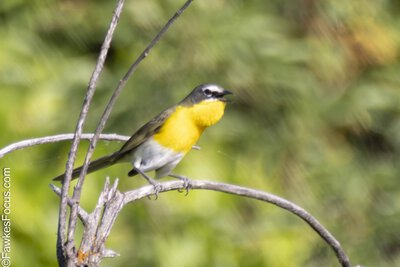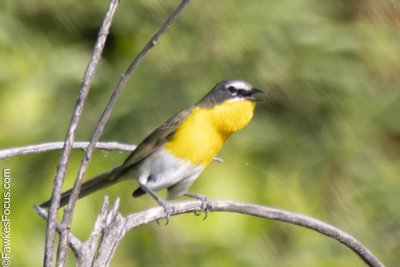Yellow Breasted Chat: Photos, Identification, Habitat, and Birding Guide
The Yellow-breasted Chat is one of the most unique songbirds in North America. Its bold yellow chest and mix of whistles, clucks, and cackles make it stand out. It’s the biggest bird once called a wood warbler, but now it has its own family – pretty cool for scientists and birdwatchers alike. Birders usually look for this shy bird in thick, shrubby spots, hoping for a flash of yellow or a burst of its strange songs, especially in spring.
Table of Contents
ToggleIt’s not easy to spot, but the Yellow-breasted Chat lives across a huge area, breeding from southern Canada down into central Mexico, then heading to Central America for the winter. It likes thick brush and overgrown places – think old farms and tangled hedgerows. If you’re into birding or wildlife, learning about this bird gives you a peek at just how different North American songbirds can be. You can dig into more about its looks and habits at the Cornell Lab of Ornithology or the Audubon Field Guide.
Yellow-breasted Chat Photos by Fawkes Focus
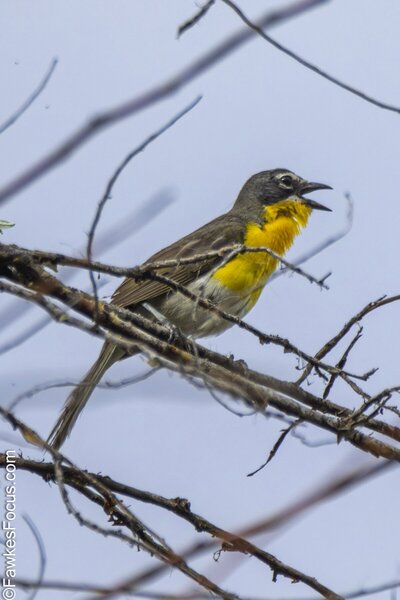
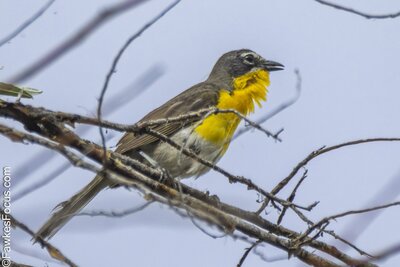
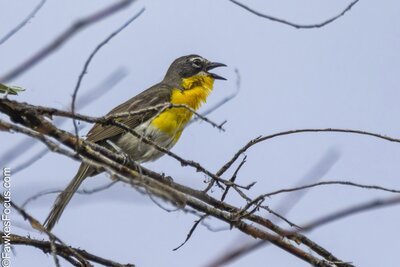

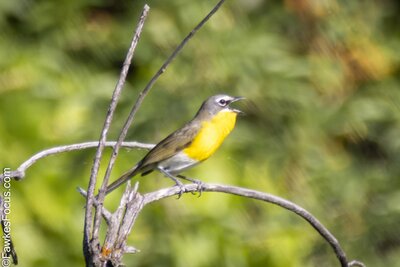



Key Takeaways
- The Yellow-breasted Chat is a one-of-a-kind North American songbird in its own family.
- Its big size and bright yellow chest make it easy to spot – if you can find it.
- Birders love it for its wild looks, crazy song, and sneaky ways.
Taxonomy and Classification
The Yellow-breasted Chat is different from other North American songbirds, both in its family status and its odd scientific name. Its classification has changed as scientists learned more about it.
Family Icteriidae and Relationship to Warblers
This bird, Icteria virens, is now in its own family, Icteriidae. For a long time, people called it a warbler and put it with Parulidae. But its big body, strange voice, and odd habits didn’t really fit.
In 2017, the American Ornithological Society moved the chat out of Parulidae and gave it its own family. Studies showed it’s just too different in body and DNA to be a true warbler.
Even though it’s not a warbler anymore, it still eats bugs and uses habitats like the parulid warblers do. It’s the only member of Icteriidae – no cousins here. Some researchers say it’s closest to blackbirds, but honestly, scientists are still arguing about that. You can read more at Yellow-breasted Chat – Wikipedia or in this species guide.
Scientific Name and Etymology
The scientific name is Icteria virens. “Icteria” is a special word made just for this bird, coming from the Greek “ikteros,” which means yellow – pretty fitting for that bright chest.
“Virens” is Latin for “green” or “becoming green,” which matches its olive-green back. So, the name basically points out the two main things you notice: yellow underneath and olive on top.
Since it’s the only species in its genus, Icteria is called a “monotypic genus.” No other birds share that name. Its odd name and family really make it stand out in the bird world. For more details, check Avibase’s page on Icteria virens.
Physical Description
The yellow-breasted chat is a flashy North American songbird with bright feathers, a chunky body, and some features you don’t see in other warblers. Both males and females are colorful, but if you look closely, you’ll spot some differences.
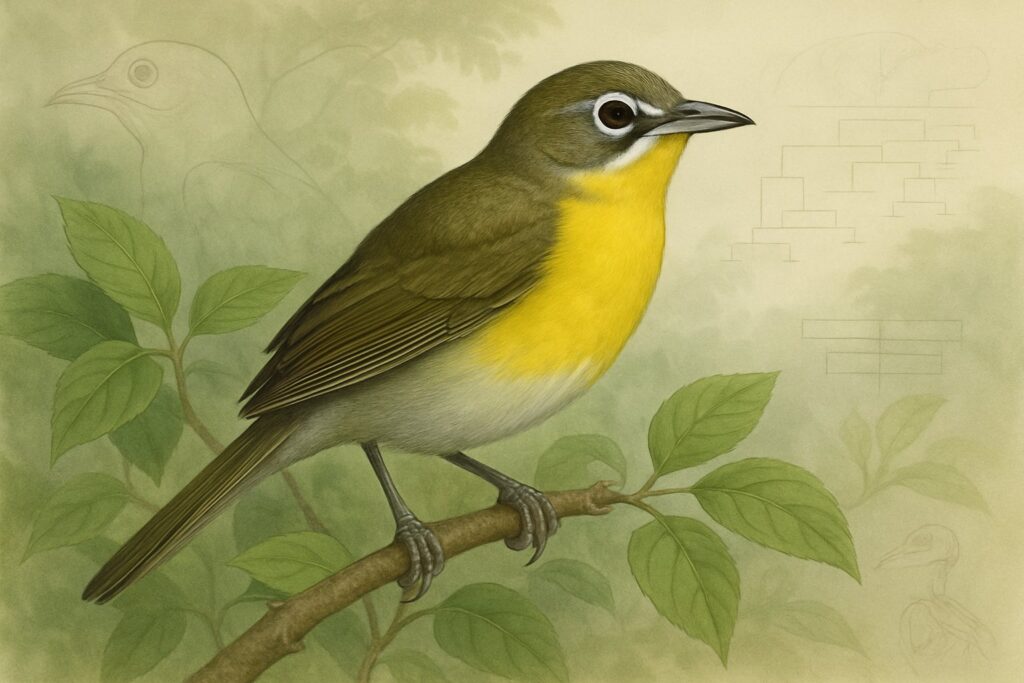
Distinctive Features
The chat is a lot bigger than most warblers and has a different shape – about 18 cm (7 inches) long with a thick, curved bill. That’s not something you see on most warblers.
Its big thing is the yellow throat and chest, with a white belly and olive-green back. It’s got a long tail and a round body, so it looks chunkier than your typical songbird. The face is grayish, with bold white crescents under the eyes and little white “whiskers.”
Even with those loud colors, it can hide really well in thick bushes. Fun fact: the yellow looks even brighter because it reflects ultraviolet light. Want more tips on spotting one? Here’s the All About Birds guide.
Sexual Dimorphism and Plumage Variations
Males and females look pretty similar, but there are small differences. Females are usually a bit heavier, while males often look brighter in breeding season. Both have black bills when breeding, but pale stripes can show up later.
Young chats look different, with dull grayish or olive-brown backs, and a lighter chin and throat – just a hint of yellow.
Their feathers change through the year, and males lose some of the bright color after breeding. The subspecies Icteria virens auricollis has a bigger tail and bill than others. For more info about sex and age differences, see the Animal Diversity Web profile.
Habitat and Distribution
The yellow-breasted chat likes thick, bushy places and lives in lots of North America. Where it goes and what it likes changes with the seasons.
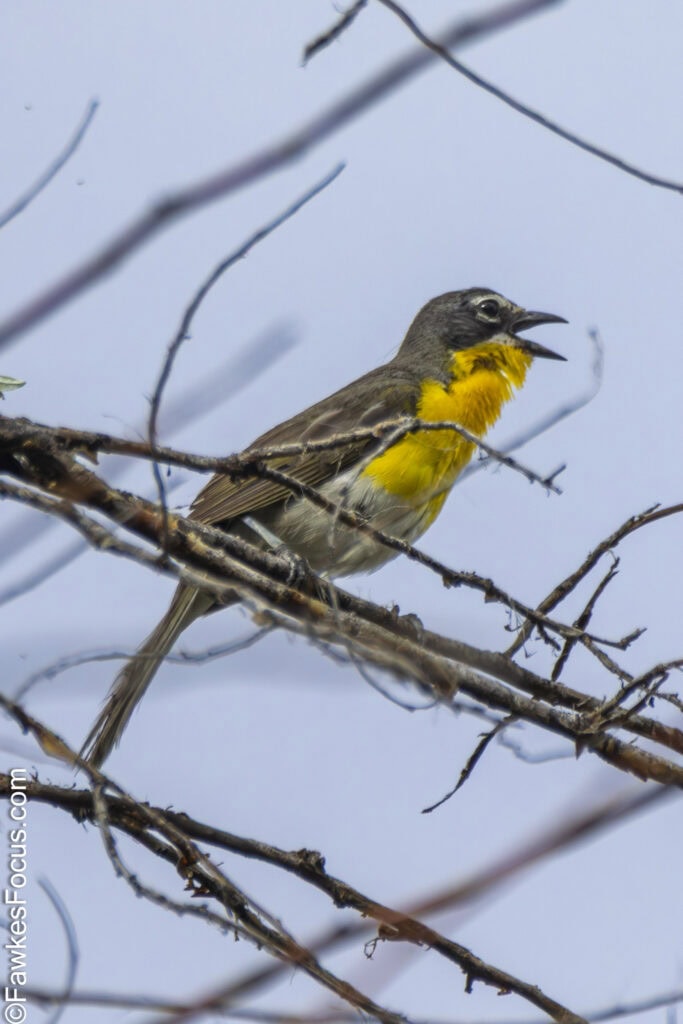
Preferred Environments
Yellow-breasted chats stick to dense thickets, tangled shrubs, and low, bushy spots. They love overgrown fields, forest edges, powerline cuts, and old farmlands with plenty of cover and food. If there are blackberry bushes or thick, fruiting shrubs, they’re probably around.
In wetter places, they hang out near streams, swamps, and woods along rivers. Out west, you might find them in shrubby spots by rivers, where there’s water and lots of hiding places. Thick cover keeps them safe and gives them places to nest.
You won’t see them much in open fields or cities – those spots just don’t have enough cover. Their love of tangled brush means you can use them as a sign that an area is nice and wild. There’s more about their favorite spots at the All About Birds Yellow-breasted Chat Life History page.
Geographic Range
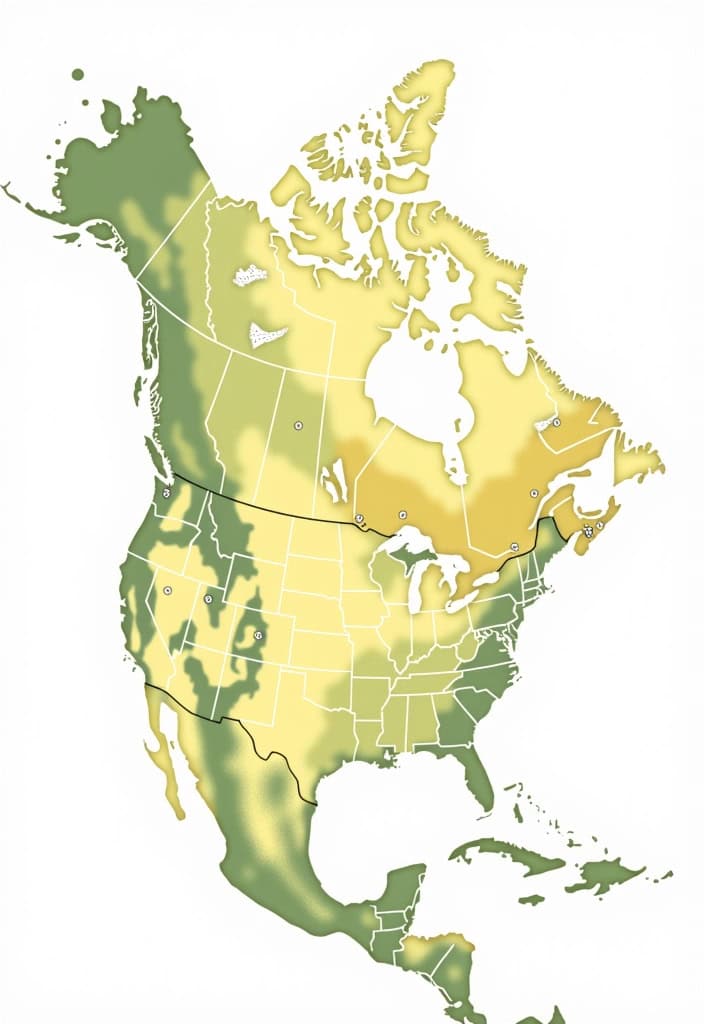
Yellow-breasted chats breed from southern Canada all across the U.S. and into central Mexico. In the eastern U.S., look for them from Iowa and New York down to Texas and Florida.
They also pop up in the Midwest and western U.S., wherever there’s good shrubby habitat. In Canada, they stay in the southern bits, where it’s warm enough and plants are thick. They avoid places with little cover or big forests.
In winter, they head south, leaving the northern parts behind. Their big but patchy range means people need to watch out for habitat loss. Here’s a summary of yellow-breasted chat habitats.
Seasonal Movements
Yellow-breasted chats migrate as seasons change. They breed in North America in late spring and summer. When fall comes, they fly to Mexico and Central America for winter.
Most chats come back to the same breeding spots every year – they’re loyal like that. Their migration can cover thousands of miles, and they stop in places with thick bushes and food along the way.
In winter, they still look for dense, shrubby spots, but might use drier areas in Mexico and Central America than in the U.S. This yearly move lets them get the best food and skip the cold. For more, see the Birda yellow-breasted chat identification guide.
Behavior and Ecology
The yellow-breasted chat acts in ways you don’t see in other birds. It’s got odd feeding tricks and breeding habits. People know it for its weird sounds, what it likes to eat, and how it nests.
Vocalizations and Song
Yellow-breasted chats are famous for their crazy mix of sounds. The male whistles, cackles, grunts, and even makes catcalls in breeding season. He’ll sing from a high perch or while flying with floppy wings and hanging legs. It’s quite a show.
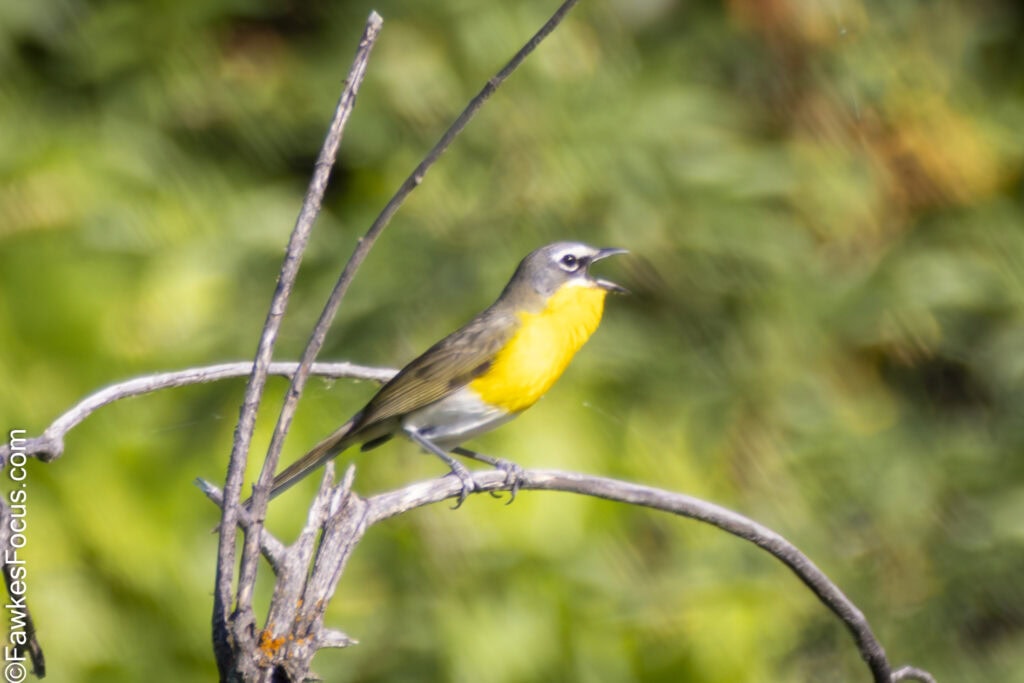
Unlike most warblers, chats mash together all kinds of sounds. Spring is the best time to hear them – otherwise, they’re quiet and hard to find in thick brush. Their hoots, clucks, and rattles make them stand out. All these sounds help them find mates and claim space. Want more? Check out these vocal displays on the Audubon Field Guide.
Feeding Habits and Diet
Yellow-breasted chats eat almost anything. When it’s warm, they go for insects like beetles, caterpillars, and spiders. They’ll also snack on berries and small fruits if bugs are scarce. This helps them live in lots of different places.
They hunt by creeping through thick bushes. Sometimes they even use their feet to hold food, which is rare for songbirds. They’re shy eaters, rarely coming out in the open. Get more details about their food and foraging on the Birda Yellow-breasted Chat Guide.
Nesting and Breeding
When it’s time to nest, the chat builds a big, messy nest deep in shrubs or briars, using grass, leaves, and roots. The female lays 3-5 speckled eggs.
Both parents feed the chicks and watch the nest. The male often sings from an open branch to attract a mate and scare off rivals. You’ll have a tough time spotting them while they’re nesting – they stay hidden and quiet to dodge predators. For more on nesting, see the All About Birds overview.
Yellow Breasted Chat in Birding Culture
The Yellow Breasted Chat holds a special spot in North American birding. With its oddball behaviors, wild sounds, and sneaky nature, it’s a favorite for birders – whether you’re just starting out or you’ve been at it for years.
Spotting and Identification Tips
If you’re trying to spot a Yellow Breasted Chat, look for a chunky bird with a bright yellow breast, white eye rings, and an olive-green back. It’s bigger and heavier than most warblers, with a thick, strong bill. In spring, the males break into a jumble of whistles, hoots, and clucks – pretty hard to miss if you’re nearby.
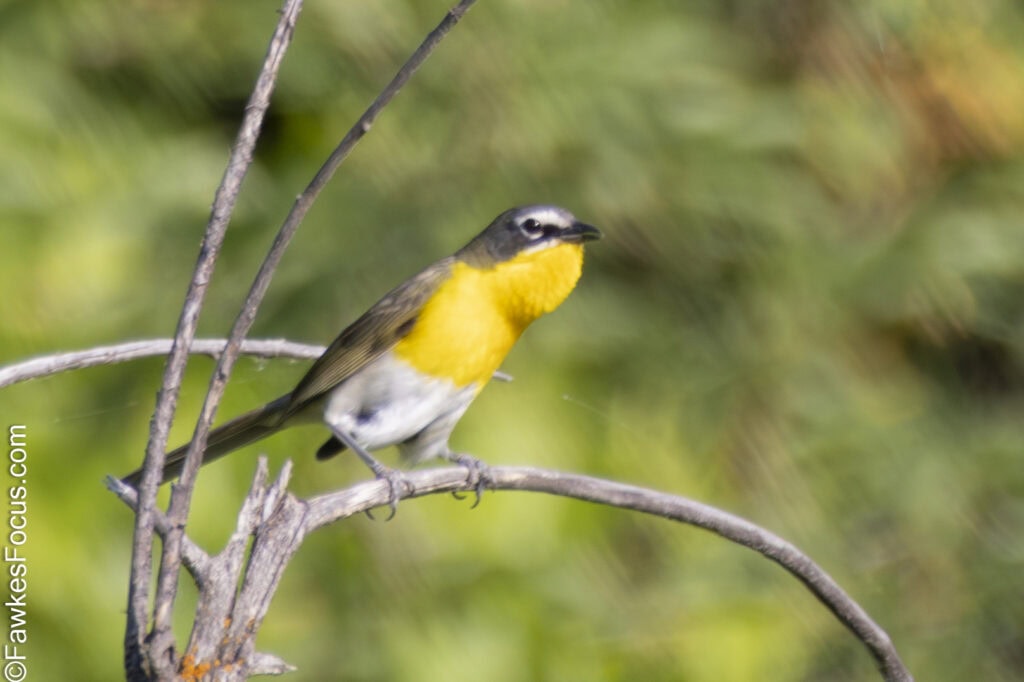
Your best bet is during breeding season, when males perch up on shrubs or small trees and sing out in the open. The rest of the year, these birds vanish into dense thickets, making them tough to find. Honestly, a good field guide or birding app comes in handy, since chats look a lot like some other species.
Their weird, varied calls really help set them apart. Binoculars with close focus make a difference, since chats love staying low and half-hidden. If you want more details, the All About Birds Yellow-breasted Chat guide is worth checking out.
Role in Birding Events
Yellow Breasted Chats pop up on birding checklists pretty often, especially during big birding events like ABA “Big Year” competitions. Birders chase this species for its wild calls, secretive habits, and patchy range.
Spring bird walks usually highlight chats, since they’re louder and easier to find then. Some birding festivals even plan special trips to shrubby fields or edges, just to boost the odds of a sighting.
Field guides sometimes list reliable spots for chats, which helps birders map out their routes. Honestly, hearing or glimpsing a chat rustling around in the brush can turn an average day into a memorable one.
Status as a Rare Bird
The Yellow Breasted Chat isn’t rare everywhere, but it’s still a big deal in places where its numbers are low or its habitat’s shrinking. In some regions, finding one can be a real challenge because they’re so sneaky and populations are scattered.
A few states call the chat a species of concern, mostly because of habitat loss. That local rarity makes it a hot target for listers chasing hard-to-find birds. When someone reports a chat outside its usual range during birding events, crowds often show up hoping to spot a “rare” for their lists.
The chat’s rare bird reputation changes with region and season, so it’s especially exciting during migration counts or ABA events. For more about its status and range, check eBird’s Yellow-breasted Chat page.
Conservation and Status
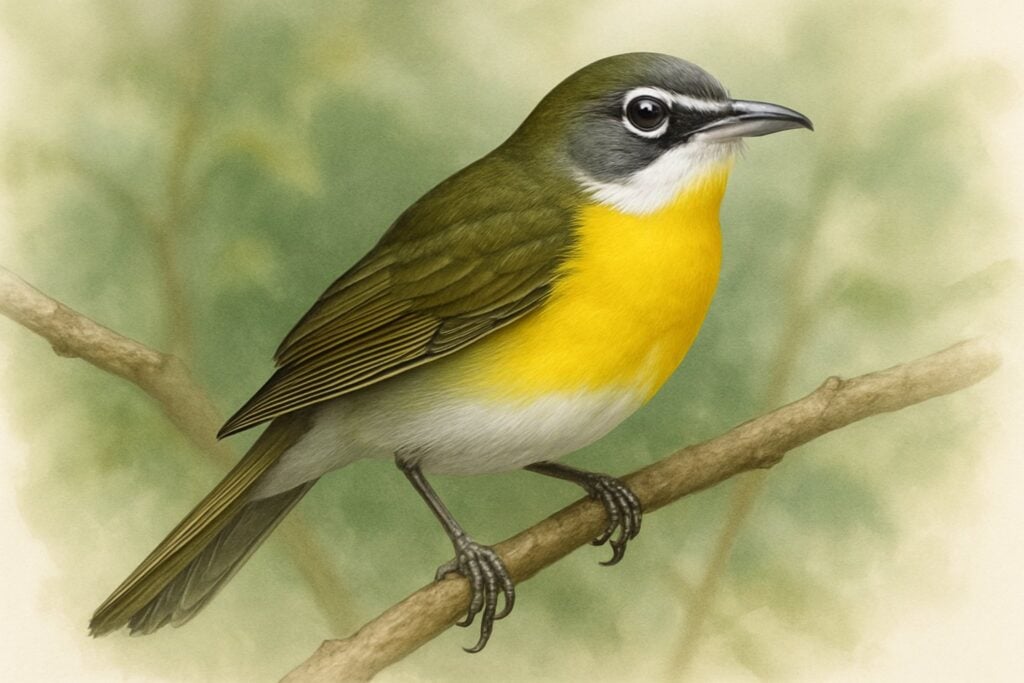
The yellow-breasted chat isn’t considered endangered globally, but numbers have dropped in some places. Population changes and threats to their habitat have made conservation actions matter more in certain states and regions.
Population Trends
The yellow-breasted chat’s population sits at about 17 million breeding birds across North America. From 1966 to 2019, numbers went down by around 32%, mostly because of habitat loss and changes in land use. Some eastern populations grew when forests got cleared for farms, but those numbers dropped again as fields turned back into mature woods.
Out west, chat populations haven’t changed as much and might even be climbing where riparian shrublands get protected. The IUCN lists the species as “Least Concern.” Still, some states and provinces – like New York and New Jersey – call the chat a species of special concern because of local declines. You can read more at the New York State Department of Environmental Conservation and Conserve Wildlife Foundation of NJ.
Threats and Conservation Efforts
The biggest threat to the yellow-breasted chat is losing dense shrubland. As forests grow up, farms get built over, or riverside shrubs disappear, chats lose their nesting and feeding spots. Mowing, grazing, and new development wipe out the low, tangled plants these birds need.
Other problems? Collisions with tall buildings and light pollution during migration can throw them off course. Climate change and more habitat breaking up don’t help, either. Conservation groups work to protect and restore shrubby places, especially along rivers and forest edges. Managing clearcuts, powerline corridors, and overgrown fields can actually help chats out. If you want a deep dive into the challenges, check out the Bird Migration Explorer.
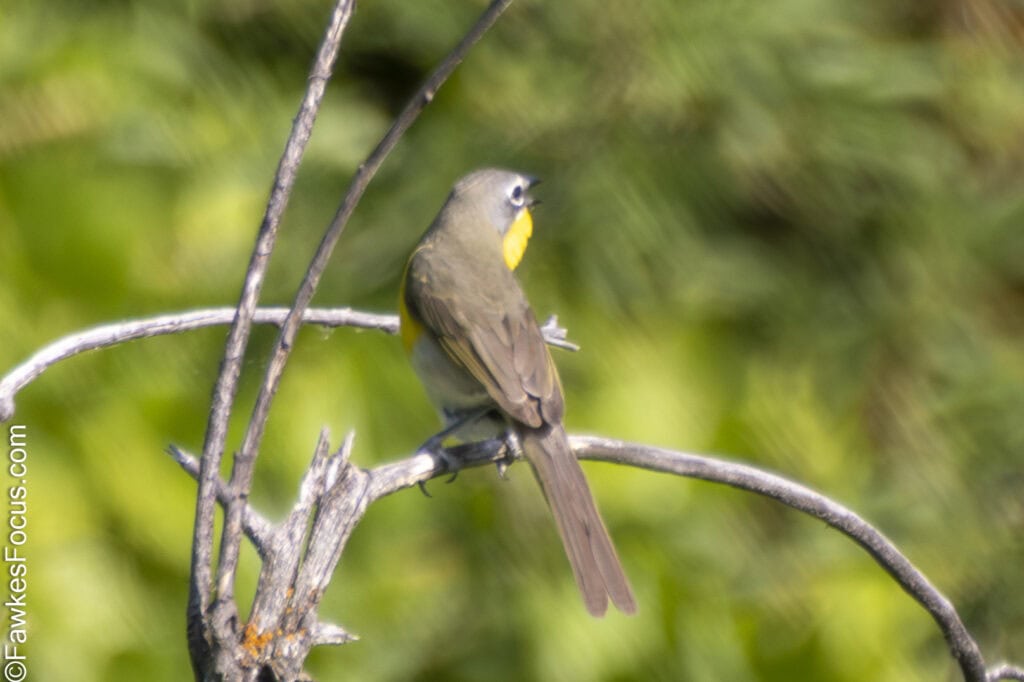
Frequently Asked Questions
The Yellow-breasted Chat stands out for its bright colors, strange calls, and love of thick shrubbery. Birdwatchers notice its size, what it eats, and the way it acts compared to other birds.
What does the call of the Yellow-breasted Chat sound like?
A Yellow-breasted Chat’s call mixes whistles, cackles, clucks, and hoots. Males get especially noisy in spring, hoping to attract a mate or defend their spot. The calls sound all over the place – sometimes like a mashup of different birds – so they’re pretty easy to pick out during breeding season.
How can one differentiate between male and female Yellow-breasted Chats?
Males and females look a lot alike, but the males usually show off brighter yellow, especially on the throat and chest. In breeding season, the male’s colors almost glow compared to the female. Both have that white eye-ring and olive-green back, so you’ve got to look close.
What is the typical diet of a Yellow-breasted Chat?
Yellow-breasted Chats mostly eat insects, spiders, and other tiny critters in spring and summer. Later on, they’ll go for berries and small fruits. They stick to thickets and low branches while foraging close to the ground, staying hidden as they search for food.
In what regions can one typically find the habitat range of the Yellow-breasted Chat?
You’ll find Yellow-breasted Chats across much of the U.S. during breeding season, from southern Canada down to the Gulf Coast. They like thick, shrubby spots near streams, woodland edges, and overgrown fields. For a full breakdown of where they live, take a look at this comprehensive habitat guide.
How does the size of the Yellow-breasted Chat compare to other birds?
They’re bigger and bulkier than most warblers – about 6 to 8 inches long. The long tail and thick bill give them a look kind of like a small tanager. Their wingspan runs about 10 to 12 inches, so for a songbird, they’re pretty robust.
What species are similar in appearance to the Yellow-breasted Chat?
Some warblers look a bit like the Yellow-breasted Chat because they also have yellow and green feathers. But the Chat stands out – it’s bigger, chunkier, and has these wild white “spectacles” around its eyes. That bold yellow chest really pops, too. Even though people used to lump it in with wood-warblers, now it’s got its own family. Curious? Check out similar bird notes.
